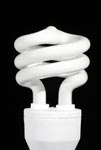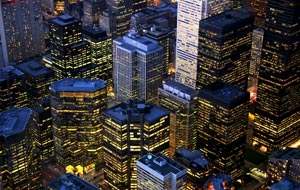Energy Effeciency & Conservation
Sundial Energy, Inc. is committed to reducing non-sustainable energy use at both the residential and commercial levels.
Save money and energy by making improvements in these areas:
Lighting:
 If every American home replaced just one light bulb with a compact fluorescent bulb, we would save enough energy to light more than 3 million homes for a year and prevent greenhouse gase emissions equivalent of more than 800,000 cars.
If every American home replaced just one light bulb with a compact fluorescent bulb, we would save enough energy to light more than 3 million homes for a year and prevent greenhouse gase emissions equivalent of more than 800,000 cars.
ENERGY STAR qualified compact fluorescent bulbs:
• Use about 75 percent less energy than standard incandescent bulbs and
last up to 10 times longer.
• Save about $30 or more in electricity costs over each bulb's lifetime.
• Produce about 75 percent less heat, so they're safer to operate and can cut energy costs associated
with home cooling.
• Are available in different sizes and shapes to fit in almost any fixture, for indoors and outdoors.
Appliances:
Did you know that the average home spends about $1,900 on energy costs every year? Change to appliances that have earned the ENERGY STAR, and you can save $80 a year in energy costs, while saving the environment.
Save Energy, Save Money
When buying an appliance, remember that it has two price tags: what you pay to take it home and what you pay for the energy and water it uses. ENERGY STAR qualified appliances incorporate advanced technologies that use 10–50% less energy and water than standard models. The money you save on your utility bills can more than make up for the cost of a more expensive but more efficient ENERGY STAR model.
Windows:
Windows, Doors, and Skylights
 ENERGY STAR-qualified windows, doors, and skylights save you energy and money, increase the comfort of your home, and protect your valuable possessions from sun damage. They are also better for the environment because lowering your energy use means less air pollution from power plants.
ENERGY STAR-qualified windows, doors, and skylights save you energy and money, increase the comfort of your home, and protect your valuable possessions from sun damage. They are also better for the environment because lowering your energy use means less air pollution from power plants.
• Save money and energy. Installing ENERGY STAR-qualified windows lowers energy bills and saves you money over single-paned and even new double-paned, clear-glass windows. $125–$450 a year when replacing single-pane windows. $25–$110 a year over double-paned, clear glass replacement windows
• More than just dollar savings. ENERGY STAR-qualified windows protect from the winter heat and summer sun, while also reducing condensation and interior fading. They can help reduce your energy bill up to 15 percent. Estimated savings vary from region to region depending on current heating and cooling costs and are generally greatest where there are hot summers, cold winters or both.
• What makes a window, door, or skylight energy-efficient? Thanks to a host of new technologies, i.e.; Low e-glass, warm edge spacers, gas fills, multiple panes, improved frame materials, ENERGY STAR-qualified windows, doors, and skylights keep your home cooler in the summer and warmer in the winter, making you more comfortable.
Window Coverings:
Quality shades and blinds can block the sun's heat out and keep your furnishings from fading. They can also act as an insulating layer between your room and glass during the winter.
Insulation:
Insulation keeps your home warm in the winter and cool in the summer. There are several common types of insulation — fiberglass (in both batt and blown forms), cellulose, rigid foam board, and spray foam. Reflective insulation (or radiant barrier) is another insulating product which can help save energy in hot, sunny climates.
When correctly installed with air sealing, each type of insulation can deliver comfort and lower energy bills during the hottest and coldest times of the year.
Insulation performance is measured by R-value — its ability to resist heat flow. Higher R-values mean more insulating power. Different R-values are recommended for walls, attics, basements and crawlspaces, depending on your area of the country. Insulation works best when air is not moving through or around it. So it is very important to seal air leaks before installing insulation to ensure that you get the best performance from the insulation.
To get the biggest savings, the easiest place to add insulation is usually in the attic. A quick way to see if you need more insulation is to look across your uncovered attic floor. If your insulation is level with or below the attic floor joists, you probably need to add more insulation. The recommended insulation level for most attics is R-38 (or about 12–15 inches, depending on the insulation type). In the coldest climates, insulating up to R-49 is recommended.
Heating and Cooling:
Programmable Thermostats
Programmable thermostats automatically adjust your home's temperature settings, allowing you to save energy while you're away or sleeping.
• They are more convenient and accurate than manual thermostats and improve your home’s comfort while containing no mercury.
• They save energy and save money on utility bills — when used properly, about $150/year
• Are better for the environment, since using less energy helps reduce greenhouse gas emissions associated with energy production
• These units save energy by offering 4 convenient, pre-programmed temperature settings — settings that try to anticipate when it's convenient for you to scale back on heating or cooling. They also allow you to program them to fit your own schedule and have manual over-rides.
• They are inexpensive and simple to install.
Ceiling Fans
Ceiling fan/light combination units that have earned the ENERGY STAR are about 50% more efficient than conventional fan/light units. This can save you $10 per year on utility bills, plus any additional air conditioning or heating savings you may gain when your fan is operated properly.
Heat & Cool Efficiently
As much as half of the energy used in your home goes to heating and cooling. So making smart decisions about your home's heating, ventilating, and air conditioning (HVAC) system can have a big effect on your utility bills — and your comfort. Guide to Energy Efficient Heating & Cooling (708KB).
Change your air filter regularly
Check your filter every month, especially during heavy use months (winter and summer). If the filter looks dirty after a month, change it. At a minimum, change the filter every 3 months. A dirty filter will slow down air flow and make the system work harder to keep you warm or cool — wasting energy. A clean filter will also prevent dust and dirt from building up in the system — leading to expensive maintenance and/or early system failure.
Tune up your HVAC equipment yearly
Just as a tune-up for your car can improve your gas mileage, a yearly tune-up of your heating and cooling system can improve efficiency and comfort.
* Efficiency information is from the ENERGY STAR website: http://www.energystar.gov


